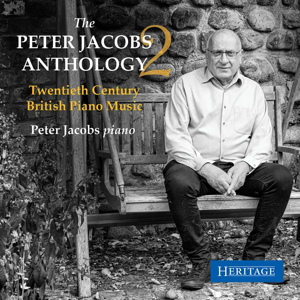
The Peter Jacobs Anthology Volume 2
Peter Jacobs (piano)
rec. 2024, Wyastone Concert Hall, Monmouth, UK
Heritage HTGCD131 [74]
This absorbing recital begins with Samuel Coleridge-Taylor’s Petite suite de concert. The four pleasing movements begin with the multiple tunes of the Schumanesque Le Caprice de Nannette. Demande et réponse [question and answer] presents a big, overblown love theme. This once was a popular salon piece, heard at pier ends and in the drawing room. We do not know the inspiration for Un sonnet d’amour, but is has been mooted that it might be a serenade to Columbine in the Commedia dell’Arte. La tarantelle frétillante [a wriggling tarantella] gives the suite an increasingly boisterous conclusion.
My personal favourite on this disc is High Marley Rest by composer/vicar Greville Cooke. It is a wonderful evocation of his piano teacher Tobias Matthay’s house High Marley in Surrey. On a clear day, there are splendid views towards the English Channel. Peter Jacobs correctly contends that this is an unknown treasure of the piano repertoire.
The rarely heard Mazurka and Waltz for a Little Girl by Frederick Delius appears because Eric Fenby, the composer’s amanuensis, was Jacobs’s harmony teacher at the Royal Academy of Music. These are the first two numbers in the Five Piano Pieces – no masterwork, but they are still reminiscent of Delius’s style. They were probably dedicated to Yvonne O’Neill, daughter of composer Norman O’Neill.
Somewhere in my collection of sheet music is a copy of English composer, pianist and musicologist Christopher Headington’s technically demanding Toccata for piano. The balance of tonal passages and twelve-note structures makes it at once modern and rooted in tradition. I disagree with the critic John Lade that it “seems overlong for its rather slender musical ideas which no manner of brilliant treatment can make really convincing”. I find it fascinating from the first note to the last.
The most significant work on this disc for me is Edmund Rubbra’s Eight Preludes. They were first given at the 1967 Cheltenham Festival. Peter Jacobs writes in the liner notes that Rubbra is an almost forgotten genius of British music. To be sure, there is no society to keep his achievement in the public eye. Yet a fair amount of his catalogue has been recorded, including all the symphonies (on Chandos) and the ‘complete’ piano music (on Dutton Epoch). All eight preludes have a “grave disposition”: they lack humour or light. They should be played as a cycle, but one is liable to be depressed by the end of twenty minutes.
It is always a pleasure to hear Cyril Scott’s best-known piano piece, the sumptuously impressionistic Lotus Land. Many years ago, it was described as “penny-postcard orientalism”. Despite this canard, Scott and Jacob manage to create just the right dreamland atmosphere. This languid evocation never fails to charm.
Cecil Armstrong Gibbs’s Lakeland Pictures were written when he and his family moved from Danbury in Essex to Westmoreland. The pieces were then lost but rediscovered in 1996. Jacobs has chosen two for this recital. The tumultuous After Rain – Rydal Beck is a non-stop number which suggests that the brook is in spate. A melancholy mood hangs over the Quiet Winter (Tarn Hows) with its thoughtful progress. Alan Cuckston issued a recording of the complete cycle in 2001 (review); I have yet to hear the full set.
A surprise discovery was Croydon-born Cecil Baumer’s Idyll. Baumer, known for his songs and piano music, was a pupil of Mathilde Verne, who was in turn a student of Clara Schumann. The work has echoes of Rachmaninov. This is definitely someone to explore, save there seems precious little readily available. WorldCat lists Puppet Piece and Alice in Wonderland with several other character studies.
I think that one will need a listening strategy to approach Anglo-Indian composer John Mayer’s Calcutta-Nagar. There are eighteen tiny ‘movements’ here, some less than half a minute, and each one has a title. We see The Rickshaw-Wallahs – in in Dharmatala Street, The River Hooghley, China Town and The New Market. One could sit down with Google Maps and explore each location, but I tended to see them as a set of variations without a theme. Certainly, they are “wistful, humorous and cheeky”, and redolent from time to time. Just occasionally there is a Spanish feel, especially in The Ghora Girls – in the horse carriages in Chowringhee Road. It is quite a delightful suite. And yes, the work got its title before the city’s official name changed to Kolkata in 2001.
I thought it unnecessary to comment on the playing of the individual pieces. The performance – committed, enthusiastic and sympathetic – is aided by an outstanding recording. The succinct liner notes by the pianist give most of the information needed to enjoy this recital. Dates of each composer would have been helpful. I corrected here a few wrong composition dates in the track listing.
For details of Peter Jacobs’s achievement, please see British Piano Collection Volume 1.
This captivating second anthology of rarely heard British piano music is a fantastic addition to Peter Jacobs’s record catalogue. One hopes that there will be many more.
John France
Buying this recording via the link below generates revenue for MWI, which helps the site remain free.

Contents
Samuel Coleridge-Taylor (1875-1912)
Petite suite de concert (c.1911)
Greville Cooke (1894-1989)
High Marley Rest (1933)
Frederick Delius (1862-1934)
Mazurka and Waltz for a Little Girl from Five Pieces (1922-1923)
Christopher Headington (1930-1996)
Toccata (1963)
Edmund Rubbra (1901-1986)
Eight Preludes, op.131 (1966)
Cyril Scott (1879-1970)
Lotus Land (1905)
Cecil Armstrong Gibbs (1889-1960)
After Rain (Rydal Beck and Quiet Winter (Tarn Hows) from Lakeland Pictures, op.98 (1940)
Cecil Baumer (1891-1937)
Idyll (1935)
John Mayer (1930-2004)
Calcutta-Nagar (1993)

















